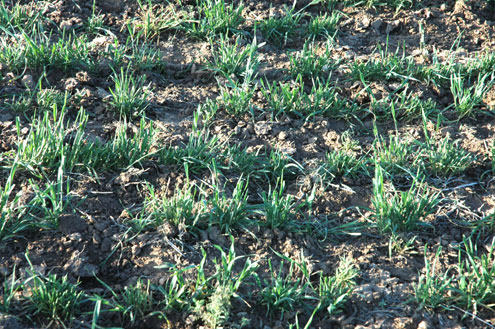COLLEGE STATION – As wheat comes out of dormancy across much of the state, the crop is suffering and expected to see reduced yields, even if some timely rains do fall, according to Texas A&M AgriLife Extension Service experts.
“If you average out the state, wheat is not great,” said Dr. Clark Neely, AgriLife Extension state small grains and oilseed specialist in College Station.
“Wheat acres went up statewide, from 4.7 million last year to 5 million this year, but most of that is in the High Plains and Rolling Plains where we have the worst drought,” Neely said. “Conditions are better in the Blacklands, but it won’t make much difference in the statewide wheat crop, because there are not many acres there.”
The High Plains are very dry, he said, adding producers with irrigation will make a crop, but only about half of what they like to see. And the dryland is really in rough shape.

If wheat was planted early enough to take advantage of some good moisture last fall, Neely said, it provided some grazing and then the cattle were pulled off. Now it is sitting there, and with some timely moisture, it could still make a grain crop.
“Without additional moisture this spring, it is difficult to see how many of the dryland acres in the High Plains are going to make a crop, some of which has already droughted out or never emerged,” he said.
In the Rolling Plains, Neely said east of Vernon had some rain and the crop is in better shape than west, where little rain fell. Fields might make 10-15 bushels per acre in the western part of the Rolling Plains, optimistically, and maybe 20 bushels in the eastern part of the Rolling Plain.
But, it would have to keep raining, he said. The recent rains alone will not be enough to get it through the rest of the season. The rainfall so far has been very sporadic in timing and location.
“Another issue,” Neely said, “is some late planted wheat is just now germinating and that will not have time to vernalize, because there are not enough chilling hours left in the season. It will stay vegetative and won’t produce a seed head, or will be poorly tillered. Anything that germinated mid-February or later is going to be doubtful.”
The wheat crop east of Interstate 35 is in pretty good shape now despite a dry fall and January, he said. In the Dallas area, records were set for the amount of rain that fell in the month of February, so the wheat should be doing good now.
In South Texas, very few acres were planted to wheat this year due to the price of wheat, Neely said.
Dr. Jourdan Bell, AgriLife Extension agronomist in Amarillo, said early planted wheat had good stands initially. However, those dense stands have used a lot of the subsoil moisture.
“If the stands are being maintained under irrigation, they are still looking good,” she said. “If they are on dryland, they are looking very poor.”
She said there also was some late–planted wheat dusted in and either it has not emerged or did emerge with very poor and uneven stands.
“But wheat is very hardy,” Bell said. “I would never want to write off a wheat crop too early. We will see a reduced yield on many fields, but if we receive some timely rains moving forward in the spring, there is the potential that poor stands could still make a wheat crop.”